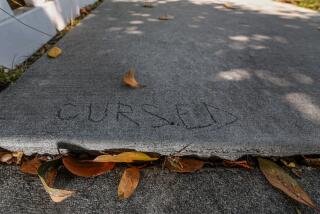Raiders of the Lost Manhole Covers Prowl the City Streets
- Share via
Armed with a metal detector and a truckload of aging maps, Dwain Ulbrich spends his days scouring the landscape for a special sort of buried treasure.
Others might prospect for gold or drill for oil, but the city of Los Angeles has a more urgent task for Ulbrich. Street maintenance workers have paved over thousands of manhole covers used to access the sewer system. He has to find them.
“I use common sense, basically,” said Ulbrich, a city field engineer, as he waved his metal detector over a Northridge intersection. “You get a feel for where they’re going to be.”
A 10-year city employee, Ulbrich finds himself in the cross-fire of a bureaucratic skirmish in City Hall. Bureau of Sanitation officials contend that their counterparts at the Bureau of Street Services are wasting money by paving over the manholes--the primary means for entering the 6,500-mile sewer system--then having an engineer track them down later.
Leaving them covered would handicap the bureau in an emergency, sanitation officials said. For the first four months of the year, the city spent about $7,000 a month to locate 1,336 manholes, according to sanitation data.
“That’s money we don’t need to be spending,” said sanitation director Judy Wilson. A city employee is “high-priced talent. We could do something more low-tech.”
Rather than hunt for the manholes, Wilson said, workers could insert small rubber cones in the asphalt to mark their locations as they pave--a practice explored by a number of Southern California cities.
Once the manhole sites are marked--either by a cone sticking out of the pavement or by Ulbrich’s spray paint--another crew will jackhammer through the asphalt and raise the manhole a few inches to make it even with the street.
Greg Scott, director of street services, cautioned that the cones are “not a foolproof method” because the work crews assigned to raise manholes could have trouble distinguishing between sewer manholes and those for other utilities.
But Scott said the city had ordered 100 cones to try out as part of a pilot program, as it races to resurface 150 miles of streets this year.
He said he was not aware that sanitation officials had been complaining about the cost of finding the manhole covers.
“This kind of comes out of the blue,” he said.
The city’s manhole contractor, Monterey Park-based Manhole Adjusting Contractors Inc., said the cones alone would probably not replace human surveyors.
“There’s no other way,” said construction supervisor Darren Cook. Even if the city used color-coordinated cones to tell different contractors which manholes to raise, Cook said, the city’s savings probably would be erased by an increase in the contractors’ bids.
Since January, sanitation bureau crews have taken over about one-third of the manhole work that had been contracted to Cook’s firm.
Wilson, the sanitation director, said her work crews have performed the job at a lower cost. Data from the department for the first four months of the year shows that the city workers raised the manholes for an average of $288 each, while the contractor did it for an average of $344 each.
But Wilson said the city would save even more if it found a more efficient way to track the manholes while paving.
Steve Healow, an engineer for the Federal Highway Administration, said cities often must pave over manholes to ensure that the asphalt compacts evenly.
But he said the Bureau of Street Services is “very shortsighted” to pave over the manholes without marking them at the same time.
“One [department] is undercutting another,” Healow said. “What’s needed is for the left hand to talk to the right hand.”
More to Read
Sign up for Essential California
The most important California stories and recommendations in your inbox every morning.
You may occasionally receive promotional content from the Los Angeles Times.










